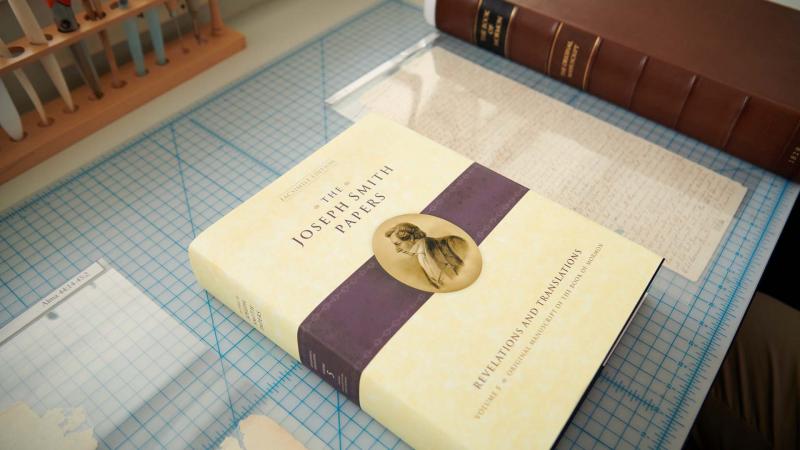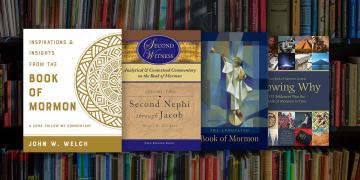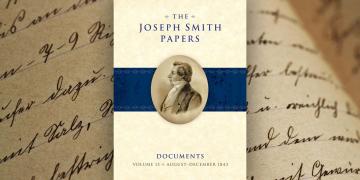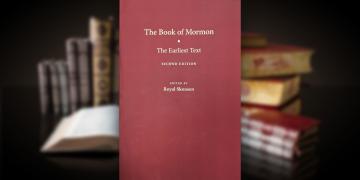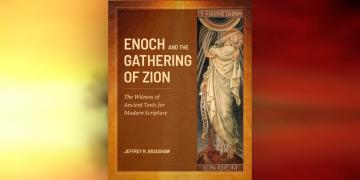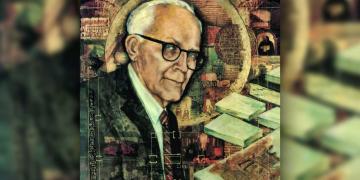You are here
Book of Mormon Central is in the process of migrating to our new Scripture Central website.
We ask for your patience during this transition. Over the coming weeks, all pages of bookofmormoncentral.org will be redirected to their corresponding page on scripturecentral.org, resulting in minimal disruption.
The Joseph Smith Papers Project, an ongoing documentary history project of The Church of Jesus Christ of Latter-day Saints, has achieved another milestone with its latest publication. Revelations and Translations, Volume 5: Original Manuscript of the Book of Mormon (R5), edited by Royal Skousen and Robin Scott Jensen, marks “the first complete photographic record of what remains of the original manuscript” of the Book of Mormon, per a recent news release by the Church. The importance of the publication of this manuscript cannot be overstated, as the text is “one of the most significant documents in the history of The Church of Jesus Christ of Latter-day Saints,” as explained on the project website. “This volume reproduces the original text based on analysis of the manuscript in its present state, as well as of multispectral images and historical photographs. The transcript preserves corrections and revisions of any kind, line and page breaks, and the locations of interlinear insertions. Since several scribes penned revisions in this manuscript, the handwriting of each is rendered in a different color to facilitate analysis. The comprehensive and careful presentation gives researchers unparalleled access to this essential text.”
The original manuscript of the Book of Mormon constitutes the text “penned by Oliver Cowdery and other scribes as Joseph Smith dictated the text of the Book of Mormon between April and June 1829.” In 1841, eleven years after the publication of the Book of Mormon in March 1830, the manuscript was deposited in the cornerstone of the Nauvoo House. Unfortunately, due to water seepage into the cornerstone, a significant portion of the manuscript was destroyed (R5, xxiv). Consequently, only “roughly 28 percent of the text of the Book of Mormon is extant in the surviving pages and fragments of the original manuscript” (R5, 5). After its removal from the cornerstone some forty years later, portions of the manuscript began to be divided among various collectors. “The Church History Library of the Church of Jesus Christ of Latter-day Saints [currently] holds approximately 90 percent of what survives; the Wilford Wood Museum in Bountiful, Utah, and the University of Utah in Salt Lake City also hold fragments, and some fragments are still in private possession. It is possible that other fragments survive but are not currently known to scholars” (R5, 5).
Being, as it is, the original dictated text of the Book of Mormon, the manuscript “is the only surviving firsthand, contemporaneous testament to events of the translation,” and “offers invaluable evidence that can be compared with secondhand accounts and later reminiscences or suppositions about the translation process” (R5, xxiv–xxv). The introduction to the volume gives a number of examples:
For instance, several individuals recalled [Joseph] Smith correcting the spelling of the scribes during the dictation process. David Whitmer, who observed the translation process in his home, stated that Smith was able to discern mistakes scribes made while taking dictation. Certainly some spelling was corrected at the time of dictation; for instance, in the book of Alma, “Zenock” was changed to “Zenoch” by Oliver Cowdery. But analysis of the manuscript itself suggests that such corrections were rare; moreover, not all errors and inconsistencies were corrected. For instance, the name “Amalickiah” in the book of Alma was not consistently spelled the same way. As another example of the value of the original manuscript, lengthy quotations from the Bible in the Book of Mormon text raise the question of whether Joseph Smith’s scribes copied some passages directly from the Bible. Close study of the manuscript indicates that the Bible passages that appear in the extant pages were dictated, not copied.
The manuscript also confirms or supports numerous details from accounts of the translation. Textual evidence in the manuscript shows that Cowdery acted as scribe for the majority of the extant manuscript, which matches his own description of the process. David Whitmer recalled years later that his brother John served as scribe for Joseph Smith as well, and John Whitmer’s handwriting does in fact appear in what is now the book of 1 Nephi. Joseph Knight, an early believer in Joseph Smith’s message, recorded that he supplied lined paper for the translation effort. The surviving portions of the manuscript reveal several different types of lined paper, which supports the idea that Smith was procuring paper in the midst of the translation process. Such correctives and confirmations of reminiscent accounts and scholarly theories illustrate the primacy of the original manuscript in establishing the history of the Book of Mormon translation.
Finally, the original manuscript offers a crucial data point in understanding the evolution of the Book of Mormon text. It is impossible to know how carefully the scribes captured the words of the Book of Mormon first spoken by Joseph Smith. Having access to the extant portions of the original manuscript of the Book of Mormon, however, allows readers the chance to assess the accuracy of the textual transmission through all subsequent editions. Even though the majority of the original manuscript is no longer extant, comparison of the extant text with the printer’s manuscript shows the care with which the copyists did their work. And while some scribal errors were introduced to the printer’s manuscript, the text shows virtually no signs of editing between the initial dictation of the original manuscript and the printing of the 1830 edition, except for spelling corrections, minor word changes, and the introduction of punctuation and capitalization. The majority of the 1830 edition was typeset from the printer’s manuscript, so the printed text was already one step removed from the original manuscript. This distance was only increased when the second edition (1837) was set from the 1830 edition, with some consultation of the printer’s manuscript but no known reference to the original manuscript. As more editions were printed—particularly after the original manuscript was deposited into the Nauvoo House cornerstone and became unavailable to those publishing later editions of the text—a number of small, unintended errors made their way into the Book of Mormon text. In spite of these errors, the text has remained remarkably stable up to the present day. (R5, xxv–xxvi)
But it is not just scholars who will benefit from this new volume. The transcription system, notations, and editorial method used in the volume make it comprehensible and welcoming for lay readers, who need not worry about getting lost in the documentary weeds. On the contrary, the reader’s experience with R5 is sure to be intuitive and rewarding no matter the extent of their previous knowledge of the Book of Mormon’s manuscript history, thanks largely to the painstaking efforts of the editors and production team to assure the text is orderly and approachable. R5 can therefore be appreciated by all Latter-day Saints, both as a scholarly and as a devotional resource. At a small gathering on January 25, 2022, President Russell M. Nelson “thanked those who helped make this volume possible” and emphasized this point, according to the Church Newsroom report.
While each volume of the Joseph Smith Papers Project “is of great significance,” President Nelson said, the books in the “Revelations and Translations” series are unique. “These revelations and translations were at the heart of Joseph Smith’s prophetic mission. These texts are vital to the Restoration of the gospel.”
Volume 5, the prophet said, “touches my heart deeply. From it, I more fully appreciate the gift and power of God that enabled Joseph Smith to translate it.”
President Nelson said the original manuscript of the Book of Mormon is one of the most significant and sacred artifacts that the Church possesses.
“Church historians have taken great care — over more than a century — to gather even the most miniscule fragments of manuscript and preserved them from further damage,” he explained. “With this new volume now available, anyone can see what remains of that manuscript and how each little piece fits into the whole. To me, it is inspiring to know that these pages with images of the original Book of Mormon text are now available to all. It is a deeply moving experience to look at these pages and see God’s hand moving His work forward.”
“On behalf of the leadership of the Church and its many members,” President Nelson concluded, “I express our heartiest congratulations and heartfelt gratitude for this newest addition to the Joseph Smith Papers Project.”
A lengthy and insightful introduction published in R5 provides a thorough background to the manuscript, including the history of the translation of the Book of Mormon and the history of the manuscript itself from its composition to its subsequent transmission and archival status (R5, xi–xxvi). Three appendices catalogue manuscript leaves of disputed authenticity, including the arguments for and against the genuineness (R5, 515–545), additional photographs of the manuscript (R5, 547–740), and updates to an earlier transcription of the manuscript previously prepared by volume coeditor Royal Skousen in 2001 as part of the Book of Mormon Critical Text Project (R5, 741–743). Other reference works (including maps, timelines, and bibliographies) help orient the reader with academic resources very useful for additional study.
As Book of Mormon studies continue to advance, Revelations and Translations, Volume 5: Original Manuscript of the Book of Mormon will undoubtedly stand out as a fundamentally important contribution to the field. At the same time, average Latter-day Saints who cherish the Book of Mormon as scripture will benefit tremendously from R5 and its vivid contextualizing of the origins of “the most correct book.”
Subscribe
Get the latest updates on Book of Mormon topics and research for free


